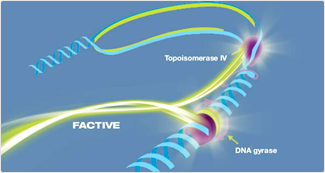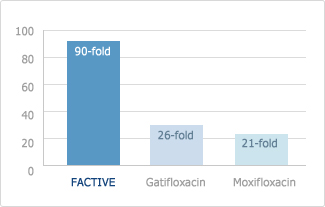Important Safety Information
THE SAFETY AND EFFECTIVENESS OF FACTIVE IN CHILDREN, ADOLESCENTS (<18 YEARS OF AGE), PREGNANT WOMEN, AND LACTATING WOMEN HAVE NOT BEEN ESTABLISHED.
FACTIVE is contraindicated in patients with a history of hypersensitivity to gemifloxacin, fluoroquinolone antibiotic agents, or any of the product components. Serious hypersensitivity and/or anaphylactic reactions have been reported in patients receiving fluoroquinolone therapy, including FACTIVE. Hypersensitivity reactions reported in patients receiving fluoroquinolone therapy have occasionally been fatal. These reactions may include serious, sometimes fatal skin reactions such as toxic epidermal necrolysis or Stevens-Johnson Syndrome; effects on the liver, including hepatitis, jaundice, and acute hepatic necrosis or failure; renal toxicities including interstitial nephritis and/or acute renal insufficiency or failure; and hematologic effects, including agranulocytosis, thrombocytopenia, and other hematologic abnormalities. These reactions may occur following the first dose or multiple doses. FACTIVE should be discontinued immediately at the first sign of an immediate type I hypersensitivity skin rash or any other manifestation of hypersensitivity reaction.
Fluoroquinolones, including FACTIVE, are associated with an increased risk of tendinitis and tendon rupture in all ages. This risk is further increased in older patients usually over 60 years of age, in patients taking corticosteroid drugs, and in patients with kidney, heart, or lung transplants. Call your healthcare professional right away at the first sign of tendon pain, swelling, or inflammation. You should stop taking FACTIVE until tendinitis or tendon rupture have been ruled out, and avoid exercise and using the affected area.
Fluoroquinolones may prolong the QT interval in some patients. FACTIVE should be avoided in patients with a history of prolongation of the QTc interval, patients with uncorrected electrolyte disorders (hypokalemia or hypomagnesemia), and patients receiving Class IA or Class III antiarrhythmic agents.
Rare cases of peripheral neuropathy have been reported in patients receiving quinolones.
In clinical studies with FACTIVE, central nervous system (CNS) effects have been reported infrequently. As with other fluoroquinolones, FACTIVE should be used with caution in patients with known or suspected CNS diseases. If CNS reactions occur, FACTIVE should be discontinued and appropriate measures instituted.
Clostridium difficile associated diarrhea (CDAD) has been reported with use of nearly all antibiotic agents, including FACTIVE. If diarrhea occurs, evaluate for CDAD and treat appropriately.
In clinical trials, rash occurred more often with FACTIVE than therapy with comparator agents (2.8% vs. 0.6%). Increasing incidence of rash was associated with younger age (especially below 40), female gender, use of hormone replacement therapy, and longer duration of therapy.
Moderate to severe photosensitivity/phototoxicity reactions can be associated with the use of quinolones after sun or UV light exposure. Excessive exposure to the sun or UV light should be avoided.
Magnesium- and/or aluminum-containing antacids, products containing ferrous sulfate (iron), multivitamin preparations containing zinc or other cations, or Videx® (didanosine) chewable/buffered tablets or the pediatric powder for oral solution should not be taken within 3 hours before or 2 hours after FACTIVE. Sucralfate should not be taken within 2 hours of FACTIVE.
In clinical trials, the most common adverse drug reactions (≥2%) were diarrhea, rash, nausea, headache, abdominal pain, vomiting, and dizziness.
This product is available by prescription only.
* Videx® is a registered trademark of Bristol-Myers Squibb Company.
For US residents,
You are encouraged to report negative side effects of prescription drugs to the FDA. Visit www.fda.gov/medwatch, or call 1-800-FDA-1088.
For Non-US residents,
You are encouraged to report negative side effects of prescription drugs, please click here or call 82-2-6924-3620.
Please note that the information contained on this site is intended for international health care providers and may not be appropriate for your country of origin. Please see the full FACTIVE prescribing information for your country for approved product indications, dosing, and important safety considerations. Click on the "Global Countries" tab above to learn how to obtain country-specific prescribing information.
 FACTIVE displays strong binding affinity at dual target sites of action, which helps maintain high in vitro potency even against resistant S pneumoniae. FACTIVE works differently from most of the others, it is often effective against pathogens that are resistant to other drugs.
FACTIVE displays strong binding affinity at dual target sites of action, which helps maintain high in vitro potency even against resistant S pneumoniae. FACTIVE works differently from most of the others, it is often effective against pathogens that are resistant to other drugs. To kill bacteria, an antibiotic must reach the place where the bacteria are causing trouble - the infected tissues. FACTIVE does this. FACTIVE rapidly penetrates and concentrates in the respiratory tissues. This means it works fast to provide high levels of antibacterial activity right where the infection is.
To kill bacteria, an antibiotic must reach the place where the bacteria are causing trouble - the infected tissues. FACTIVE does this. FACTIVE rapidly penetrates and concentrates in the respiratory tissues. This means it works fast to provide high levels of antibacterial activity right where the infection is.







